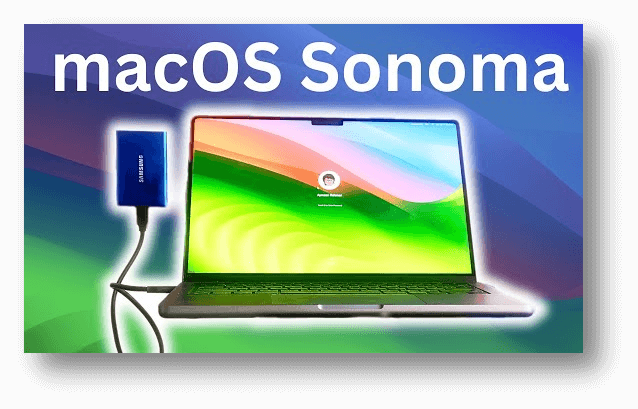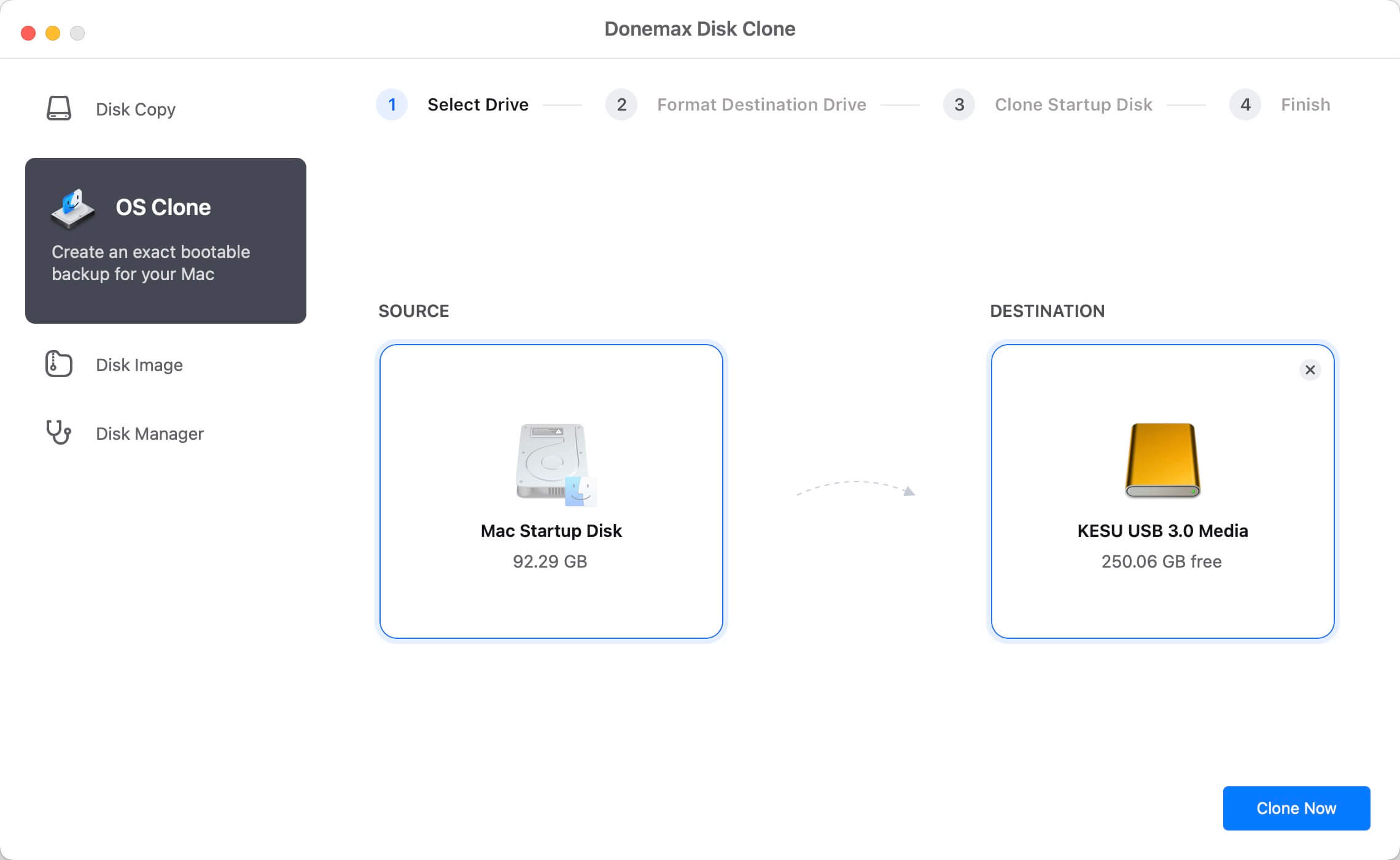PAGE CONTENT:
There are many reasons behind why you want to clone macOS Sonoma to an external hard drive or USB flash drive.
- Clone macOS Sonoma to an external hard drive to make a bootable clone.
- Clone a damaged Mac hard drive to an external hard drive before sending the Mac to a repair store.
- To prevent data loss, make a backup of the entire macOS Sonoma.
- Restore macOS Sonoma to another Mac with the clone backup.

How to clone macOS Sonoma to an external hard drive? How to make a bootable clone for macOS Sonoma? How to move everything including macOS Sonoma, apps, settings, user files from the Mac to an external hard drive? Just read on.
How Is Mac Hard Drive Cloning for macOS Sonoma?
When you clone the hard drive in your Mac, you make an exact copy of the drive. It contains all the necessary information to boot your system from that backup. It's only a temporary fix for a pressing problem, but having it on hand is invaluable.
You'll need to download some additional software to make a copy of your macOS Sonoma hard drive that can be booted. Donemax Disk Clone for Mac, SuperDuper!, Carbon Copy Cloner, and EaseUS Todo Backup are just a few examples. You may try out different ones and see which one serves your needs best because they all provide free or trial versions.
Prepare An External Disk for A Mac Clone
You must get your external HDD or SSD ready for storage before you clone your Mac. You must utilize an empty external hard drive to make a bootable disk for the cloned data. Here are the measures to take:
- Join the external hard drive to the Mac.
- Launch Disk Utility from your computer's home screen.
- In the left sidebar, choose the external drive you wish to use.
- Select the Erase button in the main toolbar.
- Choose the Mac OS Extended or APFS format and give your disk a name.
- The Erase button must be clicked.
- When you're done, click the Done button.
Clone macOS Sonoma to An External Hard Drive with Disk Clone Software
Disk cloning software can help Mac users quickly clone Mac startup disk to another HDD or SSD. If you want to clone macOS Sonoma to an external hard drive such as Seagate, WD, Toshiba, Samsung, you can download a disk cloning application - Donemax Disk Clone for Mac. Then install this macOS Sonoma clone software on your Mac and run it from Launchpad.
Donemax Disk Clone for Mac offers three disk cloning modes: Copy hard drive, OS Clone and Create Disk Image. It is recommended to choose OS Clone mode to clone everything of the Mac to an external hard drive, creating a bootable clone backup.
Step 1. Download and install Donemax Disk Clone for Mac, open it. Connect the external hard drive to your Mac.
Step 2. Choose OS Clone mode, select the external hard drive as the destination drive.

Step 3. Click on Clone Now button to clone macOS Sonoma, user files, settings, apps and other data from the Mac disk to the external hard drive.

FAQs About macOS Sonoma Disk Clone
❓1.What is the best disk cloning software for macOS Sonoma?
Here is the list of top 5 disk cloning software for macOS Sonoma:
- Donemax Disk Clone for Mac
- SuperDuper
- Carbon Copy Cloner
- DoYourClone for Mac
- EaseUS Todo Backup
❓2.How to clone macOS Sonoma to an external hard drive?
- Download and install Donemax Disk Clone for Mac.
- Connect the external hard drive to your Mac
- Open Donemax Disk Clone for Mac, choose OS Clone mode.
- Select the external hard drive as the destination drive.
- Click on Clone Now button.
❓3.How to set the external drive as the boot drive after clone?
If you have made a bootable clone for macOS Sonoma, you can connect the external hard drive to any Mac. Then restart the Mac into macOS Recovery mode, select the external hard drive as the boot drive. Then your Mac will boot from the clone backup.
❓4.Can I clone macOS Sonoma hard drive with Disk Utility?
Yes. Disk Utility is an application with macOS that may clone hard drives. Let's go over the steps necessary to clone your Mac's hard drive without spending any money:
- Initiate the Disk Utility. Spotlight Search can be used to locate and launch the necessary program for this purpose. You may open Disk Utility by pressing Command and Space at the same time. Then, it will be one of the options presented.
- When you're ready to clone your Mac hard drive, run Disk Utility and choose the backup drive you want to use as the target drive. The last step is to select the Restore button.
- A submenu titled "Restore from" will appear in a new window when you launch Disk Utility. To begin cloning, choose your Mac's SSD as the source device and click Restore.
- Then, as Disk Utility clones your drive, a progress meter will appear and gradually fill up. You can confirm the action by selecting the Done button when it's done.
Conclusion:
To prevent data loss is one of the main reasons why a Mac user wants to clone macOS Sonoma to an external hard drive. Donemax Disk Clone for Mac, a powerful & easy-to-use disk cloning application, can help Mac users quickly clone macOS Sonoma to an external hard drive and make a full bootable clone backup. This software also can create DMG backup for macOS Sonoma or copy macOS Sonoma hard drive data to another disk drive.
Related Articles
- Aug 20, 2024How to Create a Disk Image on Mac?
- Nov 27, 2024Create Bootable Clone Backup for macOS Sonoma: A Complete Guide
- Jul 14, 2023How to Transfer Data Between Mac and Windows PC?
- Apr 01, 2025How to Create a Bootable Clone for MacBook Pro? [M1/M2/M3/M4 Supported]
- Jun 21, 2023Free Download EaseUS Disk Copy for Mac Alternative Software
- May 23, 2023Clone APFS Disk Volume on Mac with Two Methods

Lucien
Lucien is a writer and a chief programmer of Donemax software who has worked in the company for 5+ years. He has written much of the content on the site and devotes to providing troubleshooting and solution for Windows and Mac users including disk cloning, data recovery, migration, eraser, error fixes.

Gerhard Chou
In order to effectively solve the problems for our customers, every article and troubleshooting solution published on our website has been strictly tested and practiced. Our editors love researching and using computers and testing software, and are willing to help computer users with their problems